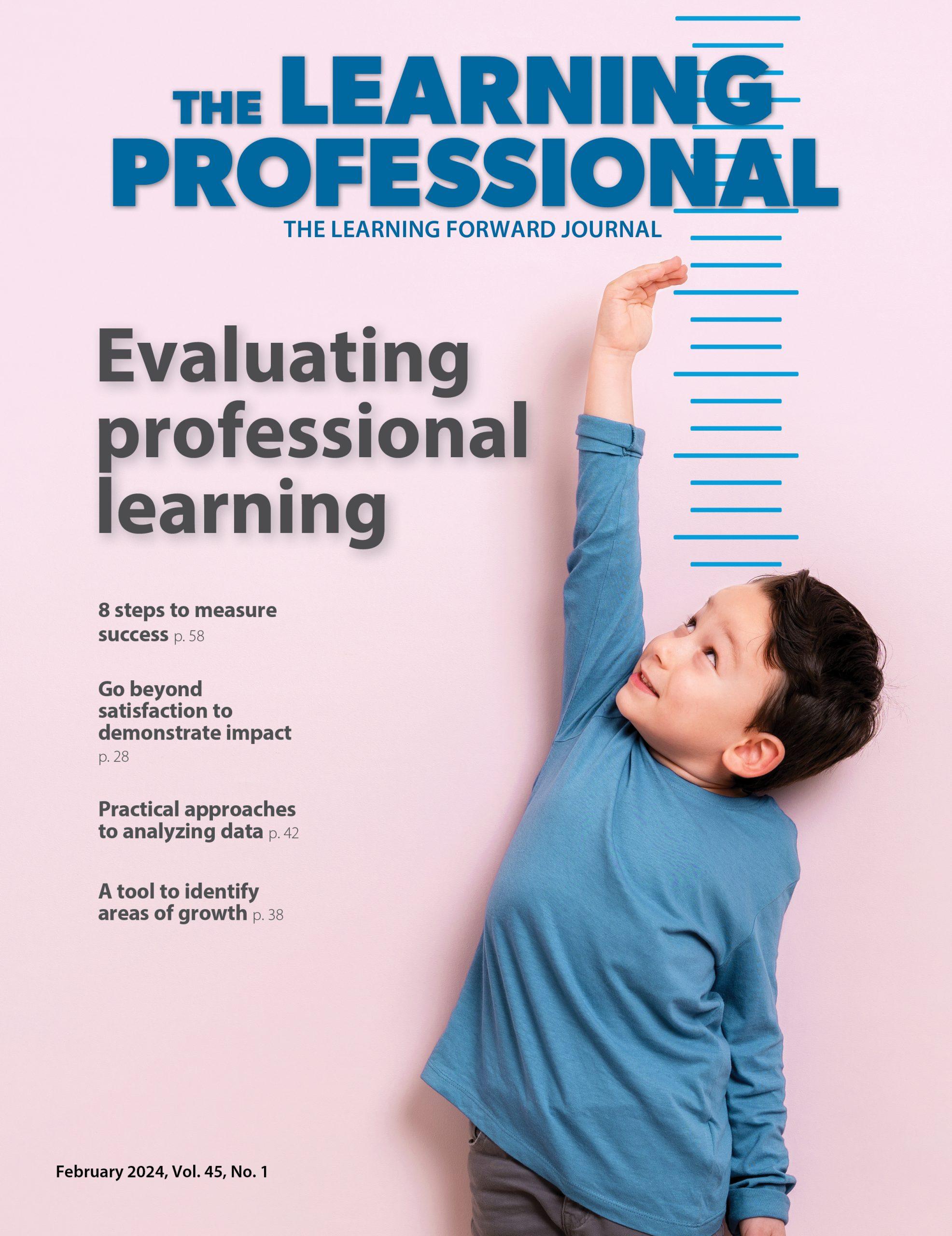Strike the right balance
How do school leaders balance district priorities with school and staff learning needs?
By Donna Micheaux
Categories: Learning communities, Learning designsOctober 2016
Vol. 37 No. 5
What drives professional learning — personalized individual staff and school needs or districtwide goals? This is the question that educators in Pittsburgh Public Schools and other districts across the country are grappling with as we redesign professional learning.
Striking the right balance between overarching, district-led professional learning initiatives and allowing schools the flexibility to work on issues that are unique to the needs of their staff members and students is a common problem of practice.
As part of the Redesign PD Community of Practice, which includes 22 school systems across the country, Pittsburgh Public Schools is working to build greater alignment and coherence into its professional learning efforts. That means creating a districtwide professional learning system that helps us grow collectively, while at the same time allowing for differentiated and personalized learning to meet the individual needs of our teachers and unique schools. How do schools find the right balance?
In our district, we have begun to strike a better balance by providing a range of professional learning experiences that include districtwide initiatives for teachers and school leaders, individualized coaching, professional learning for small networks of schools and staff members, and school-based efforts.
This past year, the district provided seven full-day Leading and Learning Institutes for principals and other school leaders and three districtwide professional development days for teachers. These sessions help principals, teachers, and coaches build content knowledge in English language arts, mathematics, and science and develop a shared vision of quality teaching and learning.
In short, the goal was to build the instructional capacity of principals and teachers by helping them to learn, recognize, and implement specific, content-based instructional strategies. We also want to create a common set of instructional expectations across our classrooms to ensure equitable access to rigorous learning experiences for all students, regardless of where they attend school in the district.
While we will continue to provide districtwide professional learning for school staff, we fully expect principals, teachers, and other district leaders to regularly examine their own data and engage in professional learning that addresses their specific needs. In other words, districtwide efforts should not replace school-based professional learning, nor should it be viewed as an excuse for not working on areas in which individual teachers and schools need to grow.
So, how do school leaders balance district-driven priorities with staff and school-specific learning needs? We set out to answer that question.
During the 2015-16 school year, I, along with a team of central office staff, conducted learning school visits at several schools to learn more about promising practices that show how school leaders and their staff members successfully balance district-driven professional learning priorities with school-based efforts. Here are examples of school leaders who are able to find the right balance.
Concord Elementary School
Concord Elementary School, in southeast Pittsburgh, has a growing English as a second language population, and Principal Michael Perella and his staff treat all students as language learners.
After Perella’s first year, it became clear that students were struggling with writing. An analysis of state assessment data showed students’ scores in writing had dropped. This finding was supported by classroom observations and work samples showing that some students could not write complete sentences.
The Pennsylvania Core Standards in English language arts expect students to write well at every grade level. Perella and his staff knew they had to take action.
“We feel it’s important for a student to develop skills in writing,” Perella says in a video created about the school’s progress. “It’s one of those skills that is essential in just about every profession.”
So, while Perella and his staff fully participated in the districtwide professional learning on phonics and text-dependent analysis, they launched an intensive school-based instructional focus on the Writer’s Workshop. He and his staff engaged in intensive school-based professional learning to build their capacity to implement the writing process.
The school’s instructional coach and assistant principal led staff members in school-based professional learning designed to equip them with the skills needed to help students become better writers.
Using a phased-in approach, they decided to allow K-1 classrooms to continue focusing on the phonics strategies emphasized districtwide while implementing an intensive launch of Writer’s Workshop in a few 2nd- through 5th-grade classrooms. They drew on the expertise of teachers in those grades who already had experience with the model.
By using this approach, they were able to build the skills of a few teachers and students who could then serve as a resource to others — a benefit that is often lost in the midst of districtwide professional learning. Job-embedded professional learning allows teachers to improve their practice in an authentic setting and promotes buy-in at a faster pace.
The teachers used author’s studies, mentor texts, and mini-lessons and provided students with feedback based on the core standards. In addition, staff members learned how to teach students peer editing skills and how to give feedback on their classmates’ writing.
This broader emphasis on the Writer’s Workshop model, with a specific focus on getting students to learn to write and write to learn, has helped both teachers and students at Concord Elementary become stronger writers. This year’s state assessment data shows growth in English language arts as well as in math and science.
“When we started this process, I did not consider myself an expert at writing,” says Christy Baraff, a 3rd-grade teacher at Concord. “I certainly have grown in terms of my ability to deliver quality instruction and releasing control to the students to explore their own writing abilities.”
Teachers are not only seeing themselves as better writers, they are seeing growth in their students that far exceed their expectations. “Students are willing to take risks and have gone places they would not have gone without the space and freedom to write,” one teacher reports. “Some students have gone from barely writing a sentence to writing five-paragraph essays.”
Students have embraced the Writer’s Workshop model and share similar excitement and enthusiasm about the writing process. “It feels great to read my stories and have others tell me how my writing can improve,” one student says.
Carrick High School
Following districtwide professional learning on algebra and biology, Carrick High School felt the need to go further into helping students monitor their own progress by better understanding their data. Reviewing districtwide assessment results can only tell part of the story. To Principal Angel Washington, it was important for staff members and students to review their own data in order to differentiate instruction to meet students’ needs.
Washington began this approach by conducting classroom walk-throughs with her administrative team. She then turned over implementation of the work to the teachers, who grouped students based on their academic needs and assigned them to teachers with the most expertise in the content areas where the students needed extra support.
The students use data binders to monitor their own progress and set personal goals. In another video, math teacher Julie Bramer describes how students are learning to make the connection between their attendance and their grades. If their attendance needs to improve, they set a goal and make a plan for how to achieve it.
“When our students look at their data, they start to own it,” Washington says. “They understand a little bit more why they are being taught what they’re being taught.”
Using specific data points allows the teachers to identify students’ strengths and target the areas where students most need to improve. Dustin Smith, a learning support teacher at Carrick, describes data as an “iceberg.” “You always see what’s on the surface,” he says, “but when you dive down underneath, you kind of get a bigger picture of what’s going on.”
Balanced approach works
Clearly, teachers and students at both of these schools are benefiting from the focus on school-based needs while still addressing districtwide instructional priorities. Recent student achievement results improved at both schools, proving that a balanced approach can work.
“The district-level professional learning did not detract from our school efforts,” Perella says about finding the right balance. “Rather, we were able to integrate and connect those parts that were relevant.”
Similarly, Washington says, “We make districtwide professional development fit. If it doesn’t make sense, we don’t do it, and we take what makes sense and make it work for us.”
Perella and Washington, and the teachers at their schools, demonstrate the ability to find balance between district-driven instructional practices and the needs of individual staff members and students. This is a balancing act that all school leaders face — and one that effective school leaders do well.
This article is part of a continuing series highlighting the educators engaging in Learning Forward’s Redesign PD Community of Practice, which supports 22 of the nation’s leading school districts and charter management organizations in addressing systemwide educator and student learning priorities. Read more at www.lfstage.xyz/redesignpdcop.
See the videos
Concord Elementary School: watch video, password PPS.
Carrick High School: watch video, password PPS.
Categories: Learning communities, Learning designs
Recent Issues
LEARNING TO PIVOT
August 2024
Sometimes new information and situations call for major change. This issue...
GLOBAL PERSPECTIVES
June 2024
What does professional learning look like around the world? This issue...
WHERE TECHNOLOGY CAN TAKE US
April 2024
Technology is both a topic and a tool for professional learning. This...
EVALUATING PROFESSIONAL LEARNING
February 2024
How do you know your professional learning is working? This issue digs...







